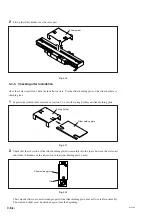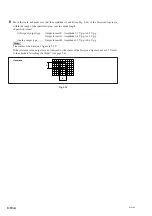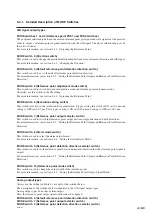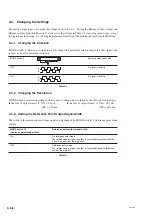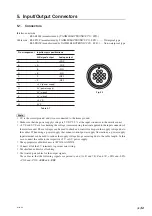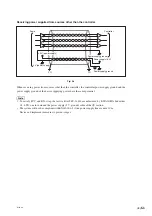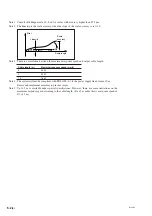
BL55-RU
(E)
4-3
4-3-1. Detailed Description of MODE Switches
A/B signal output types
MODE switches 1 and 2 (Reference point POS1 and POS2 switches)
The positional relationship between the entered reference point gate signal and scale signal must be preset in
order to output a reference point in synchronization with the A/B signal. The phase relationship is set by
these two switches.
For more information, see section 4-4-4, “Adjusting the Reference Point.”
MODE switch 3 (Direction switch)
This switch is used to change the positional relationship between scale movement direction and A/B signal.
For more information, see section 4-4-1, “Changing the Direction.”
MODE switch 4 (Default reference point detection direction switch)
This switch is used to set to the default reference point detection direction.
For more information, see section 4-4-5, “Setting the Reference Point Output and Reference Point Detection
Direction.”
MODE switch 5 (Reference point adjustment mode switch)
This switch is used to switch between interpolation mode and reference point adjustment mode.
Normally, use this switch in the ON setting.
For more information, see section 4-4-4, “Adjusting the Reference Point.”
MODE switch 6 (Resolution setting switch)
This switch is used to set the resolution. For output format F types, setting this switch to ON sets 0.1
µ
m and
setting to OFF sets 0.05
µ
m. For G types, setting to ON sets 0.02
µ
m and setting to OFF sets 0.01
µ
m.
MODE switch 7 (Reference point output selector switch)
This switch is used to switch the reference point output between single direction and both directions.
For more information, see section 4-4-5, “Setting the Reference Point Output and Reference Point Detection
Direction.”
MODE switch 8 (Alarm mode switch)
This switch is used to select the alarm output format.
For more information, see section 4-4-6, “Setting the Alarm Reset Mode.”
MODE switch 9 (Reference point detection direction selector switch)
This switch is used to set the reference point detection direction (direction that the reference point signal is
output).
For more information, see section 4-4-5, “Setting the Reference Point Output and Reference Point Detection
Direction.”
MODE switch 10 (Reference point mode switch)
This switch is used to change the output width of the reference point.
For more information, see section 4-4-3, “Setting the Reference Point Output Signal Width.”
Analog output types
Always use the settings in Table 4-1 except for the switches below.
The description of the switches below is identical to the A/B signal output types.
Analog output types do not have alarm output.
Also, the reference point output signal width cannot be changed.
MODE switch 4 (Default reference point detection direction switch)
MODE switch 7 (Reference point output selector switch)
MODE switch 9 (Reference point detection direction selector switch)
Содержание BL55-RU
Страница 2: ...BL55 RU ...
Страница 14: ...1 4 E BL55 RU ...
Страница 30: ...3 14 E BL55 RU ...
Страница 40: ...4 10 E BL55 RU ...
Страница 48: ...7 2 E BL55 RU ...
Страница 50: ...8 2 E BL55 RU ...
Страница 62: ...1 4 G BL55 RU ...
Страница 78: ...3 14 G BL55 RU ...
Страница 88: ...4 10 G BL55 RU ...
Страница 96: ...7 2 G BL55 RU ...
Страница 98: ...8 2 G BL55 RU ...






